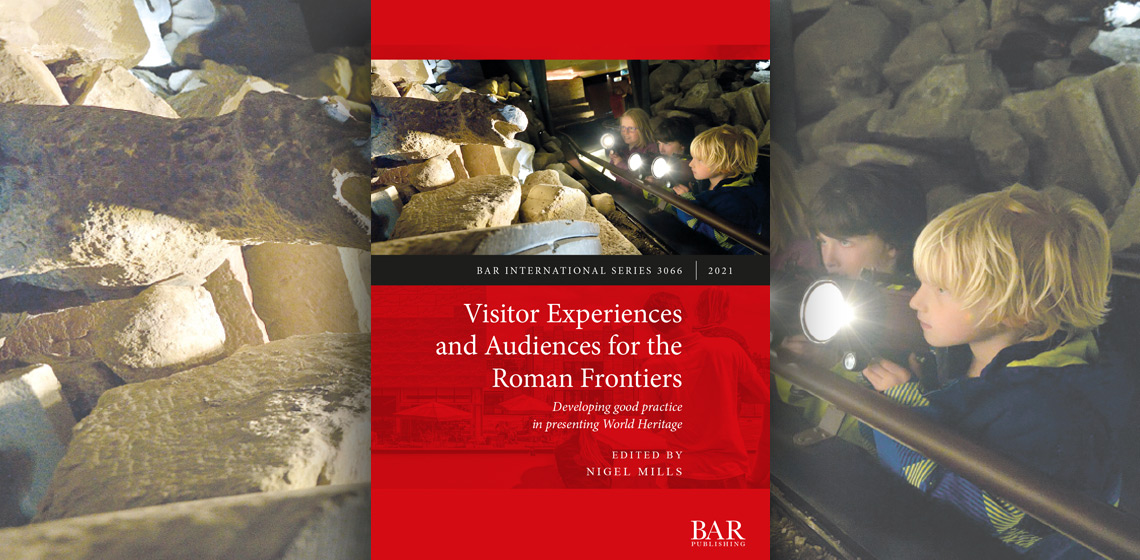The content is published under a Creative Commons Attribution Non-Commercial 4.0 License.
Unreviewed Mixed Matters Article:
Book Review: Visitor Experiences and Audiences for the Roman Frontiers by Nigel Mills (ed)

“Visitor Experiences and Audiences for the Roman Frontiers”, BAR Publishing - BAR International Series contains 14 papers presented originally at the Limes Congress in Serbia in 2018. The Limes made the headlines on a variety of occasions in recent years, being the most ambitious UNESCO World Heritage project in Europe. Not all of these headlines were positive. The extension of World Heritage Status to further parts of the Limes often meets with stagnant or even reduced budgets, a strained personnel basis and new audiences demanding more than glass display cases to rub their noses on.
The essays in this book convey three core messages for anyone having to meet these challenges, which not just apply to the Roman Limes, but to any other museum worldwide:
- Find people you can trust to create collaborations
- You cannot do enough testing (actually, you can, but the more the better)
- Dare to dip into the unknown.
Many of the essays touch on two or even three of these points while addressing their respective topics, which themselves often combine two or more of these themes:
- Finding solutions while facing odds (restrictions in budget & space, having to deal with firmly established popular ideas)
- Thinking big (organising sizable events / expositions / collaborations, often while à facing odds)
- Crossing boundaries (media, target audiences, ways of interpretation, often while à thinking big and à facing odds).
Almost half of the essays originated in the UK, with Hadrian’s Wall as prototype, avantgarde, and testing ground for the handling of Limes World Heritage. # 2 “Interpretation Frameworks” (N. Mills, who is also the editor of this book) is an ingenious meta-concept designed to avoid redundancy, competitiveness and jealousies among collaborating museums. However, the concept of “Interpretation Frameworks” itself is not recent. # 3 “Concrete for the Limes” (T. Hazenberg / C. Visser) provides a proof of this concept as it describes the use of Interpretation Frameworks in the preparations for the application for World Heritage status of the Lower Germanic Limes in the Netherlands. These two essays, together with # 15 “Public engagement with World Heritage”, emphasise the necessity of collaboration with, and involvement of, local volunteers as a backbone of long-lasting and sustainable World Heritage Site management even when, as it happened in the case of Hadrian’s Wall, the backbone is almost all that’s left after all sorts of austerity measures have passed through.
Three essays - #12 “Hadrian’s Cavalry” (B. Griffiths), #13 “A Change of Pace” (K. Booth / M. Nixon) and #14 “Turma!” (M. Bishop / N. Mills) treat the great 2017 exhibition “Hadrian’s Cavalry” at Hadrian’s Wall, and the accompanying art installation “Cavalry 360” as well as the “Turma!” re-enactment event with some 30 Roman cavalry re-enactors, providing not just great experiences for visitors and participants, but valuable data and insights. All of this could not have taken place without trustful collaboration between organisers, participants and artists. Collaboration on such a level is the desideratum of # 11 “Between archaeology and cliché” (B. Burandt), which explores the use of high-quality Roman re-enactment as a means of education and experience. It is also the foundation of the # 5 “Castellum Hoge Woerd” concept (E. Graafstal) which creates a tangible bond with the local community, thereby transcending its role as a museum. # 4 “An exhibition of their own” (A. J. Roberts), too, dwells on the topic of target audience research - families with children in this case - but I am not sure if the traces of polyvalence for an adult audience are recognisable beneath the kid stuff piled up at Birdoswald.
Admirable about # 5 “Hoge Woerd” as well as # 6 “DOMunder in Utrecht” (T. Pieren, F. Hasselaar, N. Mills) is their professional handling of (visitor) research, and their creative boldness in acting upon these data. Less ingenious, but bold in a way are the approaches described in # 10 “Communicating the Frontiers (...) in Bavaria” (C. Flügel) who spends half of his essay mocking rural roundabout decorations and other clumsy expressions of love and local identification with the World Heritage Site. The presentation of a character called “December” as presenter in the Limeseum Ruffenhofen could have gone into more detail.
Two research-heavy essays are # 7 “Viminacium” (S. Golubovic) and # 8 “The ALAPP project” (P. Weeks / E. Dobat). Viminacium is still in need of an overarching concept that makes due use of its considerable assets. It has taken an important step forward already evaluating them. The ALAPP (Advanced Limes Application) project is a well-researched and crafted app, but it is struggling with the typical problems of a project that took time to develop within a medium running at breakneck speed. It should be mentioned that approval ratings of around 50 % are not good, especially concerning apps, (I used to develop websites and apps in a previous life).
“Not good” is also a key word for the single theoretical essay of the volume, #10 “Roman frontiers in the UK: assessing the messages (...)”. It is a good essay, though, addressing underlying messages and viewpoints like “Roman Britain was a good thing” or “Romans in Britain were white” which still are often to be encountered within the audiences.
The essays radiate a can-do energy, which is a welcome ray of hope after three years of Covid-induced depression and today’s bleak wartime perspective. We need this energy more than ever.
Book information:
Mills, Nigel (ed.). 2021. Visitor Experiences and Audiences for the Roman Frontiers. BAR Publishing - BAR International Series. 198 pages. Illustrated throughout in colour and black and white. 10 tables and 125 figures.
ISBN: 9781407359007

